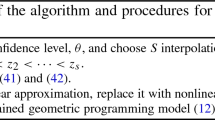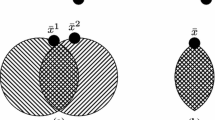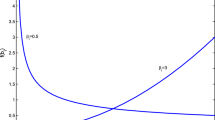Abstract
This paper discusses joint rectangular chance or probabilistic constrained geometric programs. We present a new reformulation of the joint rectangular chance constrained geometric programs where the random parameters are elliptically distributed and pairwise independent. As this reformulation is not convex, we propose new convex approximations based on the variable transformation together with piecewise linear approximation methods. For the latter, we provide a theoretical bound for the number of segments in the worst case. Our numerical results show that our approximations are asymptotically tight.

Similar content being viewed by others
Notes
The adopted solver, SDPT3, solves efficiently the dual problems. The instance sizes are given for the dual problems.
References
Agrawal GK (1978) Helical torsion springs for minimum weight by geometric programming. J Optim Theory Appl 25:307–C310
Ben-Tal A, El Ghaoui L, Nemirovski A (2009) Robust optimization. Princeton University Press, Princeton
Boyd S, Kim SJ, Vandenberghe L, Hassibi A (2007) A tutorial on geometric programming. Optim Eng 8:67–127
Cheng J, Lisser A (2012) A second-order cone programming approach for linear programs with joint probabilistic constraints. Oper Res Lett 40:325–328
Dentcheva D, Prékopa A, Ruszczynski A (2000) Concavity and efficient points of discrete distributions in probabilistic programming. Math Program 89:55–77
Dupačová J (2009) Stochastic geometric programming: approaches and applications. In: Brožová V, Kvasnička R (eds) Proceedings of MME09, pp 63–66
Duffin R, Peterson E, Zener C (1967) Geometric programming: theory and application. Wiley, New York
Embrechts P, Frey R, McNeil A (2005) Quantitative risk management. Princeton series in finance. Princeton University Press, Princeton
Fang KT, Kotz S, Ng KW (1990) Symmetric multivariate and related distributions. Chapman and Hall, London
Gorski J, Pfeuffer F, Klamroth K (2007) Biconvex sets and optimization with biconvex functions: a survey and extensions. Math Methods Oper Res 66(3):373–407
Grant M, Boyd S (2013) CVX: Matlab software for disciplined convex programming, version 2.0 beta. http://cvxr.com/cvx. Accessed Sept 2013
Henrion R, Strugarek C (2008) Convexity of chance constraints with independent random variables. Comput Optim Appl 41(2):263–276
Kogan A, Lejeune MA (2014) Threshold Boolean form for joint probabilistic constraints with random technology matrix. Math Program 147:391–427
Kotz S, Nadarajah S (2004) Multivariate t-distributions and their applications. Cambridge University Press, Cambridge
Lejeune M, Margot F (2016) Solving chance-constrained optimization problems with stochastic quadratic inequalities. Oper Res 64(4):939–957
Li Y, Wang M, Liu R (2017) Correction of a popular error in the optimization design of helical springs. Int J Model Optim 7(22):70–73
Liu J, Lisser A, Chen Z (2016) Stochastic geometric optimization with joint probabilistic constraints. Oper Res Lett 44:687–691
Luedtke J, Ahmed S (2008) A sample approximation approach for optimization with probabilistic constraints. SIAM J Optim 19:674–699
Miller LB, Wagner H (1965) Chance-constrained programming with joint constraints. Oper Res 13:930–945
Minoux M, Zorgati R (2017) Global probability maximization for a Gaussian bilateral inequality in polynomial time. J Glob Optim 68:879–898
Minoux M, Zorgati R (2019) Sharp upper and lower bounds for maximum likelihoud solutions solutions to random Gaussian bilateral inequality system. J Glob Optim. https://doi.org/10.1007/s10898-019-00756-3
Nemirovski A, Shapiro A (2006a) Scenario approximations of chance constraints. In: Calafiore G, Debbene F (eds) Probabilistic and randomized methods for design under uncertainty. Springer, London, pp 3–47
Nemirovski A, Shapiro A (2006b) Convex approximations of chance constrained programs. SIAM J Optim 17:969–996
Peterson E (1976) Geometric programming. SIAM Rev 18(1):1–51
Prékopa A (1995) Stochastic programming. Kluwer Academic Publishers, Dordrecht
Rao SS (1985) Application of complementary geometric programming to mechanical design problems. Int J Mech Eng Educ 13:19–29
Rao SS (1996) Engineering optimization: theory and practice, 3rd edn. Wiley, New York
Still G (2018) Lectures on parametric optimization: an introduction. Optimization online. http://www.optimization-online.org/DB_FILE/2018/04/6587.pdf. Accessed Mar 2019
van Ackooij W, Henrion R (2017) (Sub-) Gradient formulae for probability functions of random inequality systems under Gaussian distribution. SIAM J Uncertain Quantif 5:63–87
van Ackooij W, Henrion R, Möller A, Zorgati R (2010) Onprobabilistic constraints induced by rectangular sets andmultivariate normal distributions. Math Methods Oper Res 71(3):535–549
Uryasev S (1994) Derivatives of probability functions and integrals over sets given by inequalities. J Comput Appl Math 56:197–223
Uryasev S (1995) Derivatives of probability functions and some applications. Ann Oper Res 56:287–311
Zhao H, Chen G, Zhe Zhou J (2012) The robust optimization design for cylindrical helical compression spring. Adv Mater Res 433–440:2201–2205
Acknowledgements
The authors are grateful to two anonymous reviewers for their insightful and detailed comments and suggestions, which have helped us to improve the paper significantly in both content and style. This work was supported by the Programme Cai Yuanpei under Grant No. 34593YE; National Natural Science Foundation of China under Grant No. 11571270; Fundamental Research Funds for the Central Universities under Grant No. xzy012019060.
Author information
Authors and Affiliations
Corresponding author
Additional information
Publisher's Note
Springer Nature remains neutral with regard to jurisdictional claims in published maps and institutional affiliations.
Rights and permissions
About this article
Cite this article
Liu, J., Peng, S., Lisser, A. et al. Rectangular chance constrained geometric optimization. Optim Eng 21, 537–566 (2020). https://doi.org/10.1007/s11081-019-09460-3
Received:
Revised:
Accepted:
Published:
Issue Date:
DOI: https://doi.org/10.1007/s11081-019-09460-3
Keywords
- Stochastic geometric optimization
- Joint chance constraint
- Joint probabilistic constraint
- Elliptical distributions
- Variable transformation
- Piecewise linear approximation




